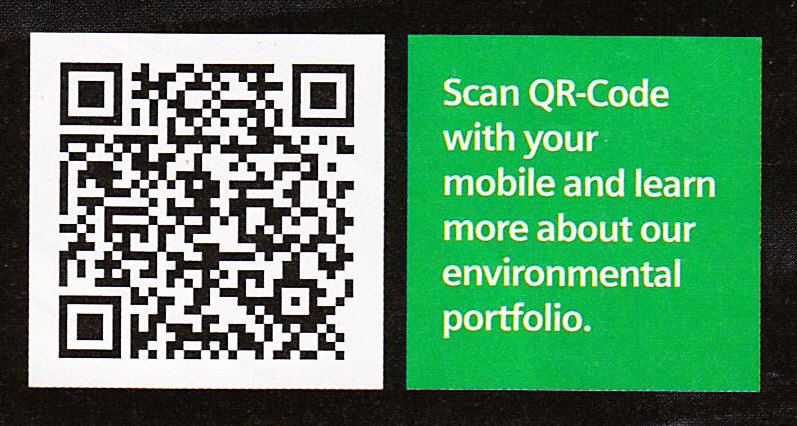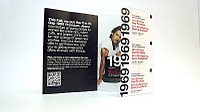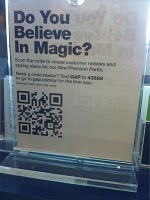How to Successfully Use 2D Barcodes in an Advertisement
 Recently, companies in the two-dimensional (2D) barcode industry, have published market research reports, indicating an increasing number of 2D barcodes are being scanned by consumers in the United States, as well as worldwide. While this research spells great news for the industry and points to the fact that consumers are becoming that much more familiar with, knowledgeable of, and interested in scanning 2D barcodes, what is less clear, however, is how companies themselves are adopting to and making use of this mobile phone-based technology.
Recently, companies in the two-dimensional (2D) barcode industry, have published market research reports, indicating an increasing number of 2D barcodes are being scanned by consumers in the United States, as well as worldwide. While this research spells great news for the industry and points to the fact that consumers are becoming that much more familiar with, knowledgeable of, and interested in scanning 2D barcodes, what is less clear, however, is how companies themselves are adopting to and making use of this mobile phone-based technology.
Through the tracking and analysis that my company does on 2D barcode use and strategy for corporate advertising and promotion purposes, it seems as though, on a gross basis, more and more companies are incorporating 2D barcodes in their advertising and promotion. However, on a net basis, each individual company is using 2D barcodes that much less.
Why should this be? Why would one set of numbers be going up while the other set is going down? Well, if success rates (i.e., an increase in advertising response rates, product sales revenue, customer loyalty, social/media buzz, etc.) have anything to do with it then, perhaps, plenty.
In the field of marketing, if a strategy or tactic proves to be successful it will often be repeated time and again until that level of success starts to diminish. If 2D barcodes, as a tactical element in a campaign, were thought to or actually proved to help drive corporate advertising and promotion campaign response rates, etc., it would stand to reason that 2D barcodes would become a standard fixture in advertisements and pieces of collateral. But this is not happening.
What we often find is that any one company will use a 2D barcode in one campaign and then never again, even though they continue to conduct traditional advertising. Or, a company may use a 2D barcode in one channel, but not across multiple channels.
The frequency and breadth of exposure becomes almost nonexistent at that point, and might lead one to believe that 2D barcodes are not generating the results that a company had envisioned or expected, so the continued use of bar codes by any one company quickly drops off.
While there are a variety of factors which might explain the lack of success and poor results that many companies have experienced with 2D barcodes, what often lies at the root of the problem is a failure to properly formulate, integrate and execute 2D barcode campaigns from the start. Oftentimes, it appears as though the use of 2D barcodes is a mere afterthought in the creative and development process. What may also be happening is that the agency pitches the idea of being viewed as cutting edge (i.e., by placing a 2D barcode) but, unfortunately, the agency has not done their homework and goes about developing and delivering a half-baked campaign.
As with many facets of marketing, there are often a number of best practices which can be deployed to ensure a greater chance of success, effectiveness and efficiency. Let’s review five of the more fundamental of best practices, as they relate to the use of 2D barcodes.
2D Barcode Best Practice No. 1
Companies must realize that a 2D barcode placed in a print advertisement or on a piece of marketing collateral is merely one more tactical method by which a company can engage and interact with a customer. It is also a gateway between the print world and the digital world. 2D barcodes in and of themselves should not be viewed as “the strategy.”
 2D Barcode
2D Barcode
Best Practice No. 2
With a 2D barcode displayed in an advertisement, the advertiser must provide a reason or use a call to action that is strong enough to attract a consumer's attention and will have them wanting to take out their mobile phone, launch a code reader app, scan the code and then filter through the content that is provided, also known as the scan resolve.
Similar to any other form of advertising, whether it be direct mail, email, internet, telemarketing, television, radio, etc., 2D bar code-based advertisements must have a meaningful and purposeful call to action, and if the call to action is focused on or directly linked to the code, all the better.
 2D Barcode Best Practice No. 3
2D Barcode Best Practice No. 3
Because 2D barcode technology is still so new in the United States, companies should not assume that consumers know what to do once they see a 2D barcode. For this reason, companies that choose to make use of 2D technology should incorporate descriptive and/or instructional copy next to the 2D barcode. This way, consumers will know what the code symbol is, where to find a code reader app, and where they will go once the code is scanned.
2D Barcode Best Practice No. 4
If by scanning a 2D barcode a consumer is brought into the digital world via their mobile device then companies need to realize that there is a vast difference between a traditional or desk/laptop internet experience and a mobile phone internet experience. When developing a 2D barcode campaign, companies should build out a mobile website to house whatever content is to be provided to the consumer. Optimizing sites and/or content for mobile is key if the advertiser wishes to keep a consumer engaged past the original advertisement and call to action message.
2D Barcode Best Practice No. 5
Companies often limit the use and exposure of their 2D barcodes to the print channel only, and this should not be the case. Instead incorporate 2D barcodes across multiple channels in order to increase exposure and response rates.
Instead of just print, companies should consider the out of home, in-store, on package, direct mail, internet and event channels, as well. If a 2D barcode is used in various channels then the company must make certain that, in each instance, the 2D barcode message and scan resolve makes sense and is relevant to that specific channel.



If your company plans to use 2D barcodes in future campaigns know that these five best practices merely scratch the surface. There are a number of other best practices to employ not only from a marketing perspective, but also from a technology perspective.
2D barcode advertising needs to be given the time, energy, resources and overall consideration that any other form of advertising (e.g., direct mail, email, telemarketing, television, radio, banner ad, landing page, text message, etc.) might take. There are no quick fixes and shortcuts are not recommended in order to be successful. Companies, as well as their agencies, must do their homework to fully understand the technology and how best to apply it. And, hopefully, the information provided in this article is a start.
 About the Author
About the Author
Roger Marquis is the founder of 2D Barcode Strategy, a marketing consultancy that focuses on the use and strategy of 2D barcode technology for marketing, advertising and general business purposes. Prior to this, Mr. Marquis held senior-level marketing management positions at leading global organizations within the financial services, technology and publishing industries, and he conceived and managed True Wind, a travel accessories company. Experienced in all aspects of the marketing mix, and knowledgeable of digital and traditional marketing practices, Mr. Marquis is considered a thought leader in the ever growing 2D barcode industry and is known for providing insightful analysis and commentary on the subject matter.
If you liked this article, also try:
- How Government Agencies Are Using QR Codes.. beginning to look toward barcoding technology and mobile apps to serve their constituencies. For many government agencies, QR codes (Quick Response codes) are the wave of the future. Here are just ...
- How Mobile and Social Loyalty Programs Can Work for Your Business.. perks including affiliate and loyalty membership accounts for hotels and airlines. Transaction ... Mobile Bar Code Trends - ... made the list, indicating that QR codes can ...
- Bar Code Marketing Gaining Mainstream Adoption, Gartner Says... offer useful insights for business and enterprise the world over. See related articles: QR Codes and Augmented Reality: Competing or Complementary? - ... up some examples to get an .
